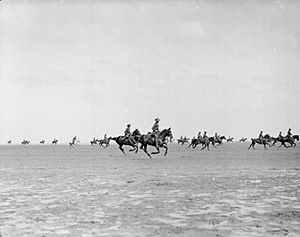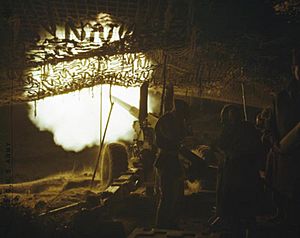Denbighshire Hussars facts for kids
Quick facts for kids Denbighshire Hussars |
|
|---|---|
| Active | 23 May 1794 – Present |
| Country | |
| Branch | |
| Type | Yeomanry |
| Role | Yeomanry Cavalry Infantry Bicycle infantry Medium artillery |
| Size | Up to three Regiments |
| Engagements | Second Boer War World War I |
| Battle honours | See battle honours below |
| Commanders | |
| Notable commanders |
Col Sir Watkin Williams-Wynn, 5th Baronet |
The Denbighshire Hussars was a special military group from Wales. It was part of the British Army. This group, called a Yeomanry regiment, was first formed in 1794.
The Denbighshire Hussars served in the First World War. After that, it changed roles and became an artillery unit. Today, its history is carried on by a unit called 398 (Flint & Denbighshire Yeomanry) Squadron, which is part of the Royal Logistic Corps.
Contents
- Early Days: Protecting the Country
- 19th Century: Keeping the Peace at Home
- Imperial Yeomanry: Serving Overseas
- Territorial Force: A New Structure
- World War I: Fighting for Freedom
- Between the Wars: Becoming Artillery
- World War II: Global Conflicts
- Postwar: Changes and New Roles
- Heritage and Traditions
- See Also
Early Days: Protecting the Country
Britain was involved in wars with France in the late 1700s. To protect the country, the government asked counties to form local cavalry groups. These groups were called Yeomanry Cavalry. They could be called upon by the King to defend against invasion. They also helped local leaders keep peace if there were problems.
A group called the Wrexham Troop was formed on May 23, 1795. Wrexham was a busy industrial town in Denbighshire, North Wales. Another group, the Denbigh Cavalry, started in Denbigh in 1799.
When the wars with France began again in 1803, more troops were formed in Wrexham. This larger group became a regiment called the Wrexham Yeomanry Cavalry.
19th Century: Keeping the Peace at Home
By 1820, the regiment was known as the Denbighshire Yeomanry Cavalry. It had five groups of soldiers. Even though many Yeomanry groups became less active after the French wars, the Denbigh regiment was sometimes called to help. They helped calm down local disturbances in the 1820s and 1830s.
For example, in 1830, they helped with a problem involving coal miners. The miners were upset about how they were paid. The Yeomanry helped to calm the situation. This event became known as the 'Battle of Cinder Hill'. The regiment continued to help keep order in the area.
In 1876, the regiment changed its name to the Denbighshire (Hussars) Yeomanry Cavalry. This showed they were now a type of cavalry known as Hussars.
Towards the end of the 1800s, the Denbighshire Hussars joined with the Montgomeryshire Yeomanry. They formed the 15th Yeomanry Brigade for training.
Imperial Yeomanry: Serving Overseas
The Second Boer War
The Yeomanry groups were usually meant for defence at home. But in 1899, Britain needed more soldiers for the Second Boer War in South Africa. The government decided to let volunteer forces serve overseas. This new force was called the Imperial Yeomanry (IY).
The Denbighshire Hussars formed the 29th (Denbighshire) Company for the Imperial Yeomanry. This company arrived in South Africa in March 1900. They served until 1901. For their service, the regiment earned its first special honour: South Africa 1900–01.
Becoming Imperial Yeomanry
The idea of mounted infantry was successful. So, in 1901, all existing Yeomanry regiments became Imperial Yeomanry. This meant the Denbighshire Hussars Imperial Yeomanry (DHIY) was much larger. They added new squadrons, including one from Caernarfonshire and another from Cheshire.
Territorial Force: A New Structure
In 1908, the Imperial Yeomanry became part of the new Territorial Force (TF). The regiment was officially named the Denbighshire Yeomanry (Hussars). It had its main headquarters in Wrexham. It also had squadrons in places like Denbigh, Bangor, and Birkenhead.
In 1911, the regiment had the special job of escorting the Prince of Wales. This was for his Investiture at Caernarfon Castle.
World War I: Fighting for Freedom
Mobilisation and Overseas Service
When World War I started on August 4, 1914, the Denbighshire Hussars prepared for war. They joined other units in East Anglia. The Territorial Force was originally for home defence. However, soldiers were soon asked to volunteer for service overseas. Many men from the Denbighshire Hussars volunteered.
Units that volunteered for overseas service were called "1st Line" units. Those who stayed for home defence formed "2nd Line" units. A "3rd Line" was also created to train new soldiers.
The 1st Line Denbighshire Hussars went to Egypt in March 1916. There, they joined other dismounted cavalry units. They formed the 4th Dismounted Brigade.
Becoming Infantry: The Royal Welch Fusiliers
In February 1917, these dismounted cavalry units were changed into infantry battalions. On March 1, the 1st Line Denbighshire Hussars became the 24th (Denbighshire Yeomanry) Battalion of the Royal Welch Fusiliers.
This new battalion became part of the 74th (Yeomanry) Division. They fought in the Sinai and Palestine campaign in 1917–18. They took part in important battles like the Third Battle of Gaza and the Capture of Jerusalem.
In 1918, the 74th (Yeomanry) Division was sent to France to help on the Western Front. The 24th RWF joined the 94th (Yeomanry) Brigade. They fought in battles in France and Belgium. The war ended on November 11, 1918. The 24th (Denbigh Yeomanry) Battalion was disbanded in 1919.
Home Service: 2nd and 3rd Line Units
The 2nd Line Denbighshire Hussars was formed in September 1914. It served in Northumberland and Yorkshire. In 1916, many Yeomanry units were changed into cyclist units. The 2nd Line regiment became part of the 10th Cyclist Brigade. It was later combined with the 2/1st Montgomeryshire Yeomanry. The unit was disbanded in October 1918.
The 3rd Line regiment was formed in 1915. It trained new soldiers. In 1917, its soldiers were transferred to other units.
Between the Wars: Becoming Artillery
After World War I, the Denbighshire Hussars reformed in 1920. The army decided it had too many cavalry units. So, many Yeomanry regiments were changed to other roles, mainly artillery.
On March 1, 1922, the Denbighshire Hussars became an artillery unit. They joined with another unit to form the 61st Carnarvon and Denbigh (Yeomanry) Medium Brigade, Royal Garrison Artillery. This new unit had its headquarters in Colwyn Bay. It had batteries (groups of guns) in places like Bangor, Llandudno, Colwyn Bay, and Wrexham.
In 1924, the Royal Garrison Artillery became part of the Royal Artillery. The unit's name changed to reflect this. In 1938, the unit became a 'regiment' instead of a 'brigade'.
As World War II approached, the unit was split into two. This created a duplicate unit.
- 61st (Carnarvon & Denbighshire) Medium Regiment
- 69th Medium Regiment
World War II: Global Conflicts
61st Carnarvon & Denbigh (Yeomanry) Medium Regiment
The 61st Medium Regiment went to France with the British Expeditionary Force. They fought bravely in the Battle of France in May 1940. After this, they were evacuated from Dunkirk, losing all their equipment.
After three years of defending Britain, the regiment joined the 21st Army Group. They took part in the Allied invasion of Normandy in July 1944. Equipped with powerful 5.5-inch guns, they fought through the rest of the campaign in North West Europe. This included the crossing of the Rhine River in March 1945.
69th Carnarvon & Denbigh (Yeomanry) Medium Regiment
The 69th Medium Regiment also fought in the Battle of France and was evacuated from Dunkirk. In 1942, they were sent to the Western Desert. They took part in the important Second Battle of El Alamein.
Later, they joined the Italian Campaign from 1943 to 1945. They ended the war in North-West Europe. Both regiments were disbanded after the war in 1946.
Postwar: Changes and New Roles
In 1947, the 61st Medium Regiment reformed as the 361 (Carnarvon, and Denbigh Yeomanry) Medium Regiment. In 1956, it merged with another regiment. It became the 372 (Flintshire, and Denbighshire Yeomanry) Regiment.
In 1967, the regiment changed again. It became The Flintshire, and Denbighshire Yeomanry, Royal Artillery (Territorial). It had its headquarters in Prestatyn.
Over the next few years, the regiment was reduced in size. In 1971, it was disbanded as an artillery unit. Its soldiers formed B (Flintshire and Denbighshire Yeomanry) Company in the 3rd (Volunteer) Battalion, Royal Welsh Fusiliers.
The Denbighshire Yeomanry name was not used for a while after 1999. However, on April 1, 2014, a new unit was formed. This was the 398 (Flintshire & Denbighshire Yeomanry) Transport Squadron. It is part of the Royal Logistic Corps in the Army Reserve. This squadron helps with transport and other important tasks.
Heritage and Traditions
Uniforms and Insignia
The Denbighshire Hussars had many different uniforms over the years.
- In the early days, they wore blue jackets with silver buttons. They wore a special helmet called a Tarleton helmet.
- By 1850, their jackets had scarlet (red) facings. Their badge showed the Prince of Wales's feathers.
- In 1856, they adopted a Hussar uniform. This had six white loops across the front. They wore a black Dragoon helmet with a red plume.
- Later, they wore a Hussar busby (a tall fur hat) with a scarlet bag and white plume.
After the Boer War, their uniform for special occasions included a drab (light brown) felt Slouch hat. This hat had a scarlet pagri (a type of turban) and a white feather Hackle. Their cap badge was the Prince of Wales's insignia.
By 1908, they went back to a blue hussar uniform for formal dress. For everyday wear, they used the standard khaki cavalry uniform.
In 1949, the 361 Medium Regiment created its own badge. It showed the Prince of Wales's insignia above a scroll. The scroll said 'CAERNARVON & DENBIGH YEO'.
Memorials
There are memorials to the Denbighshire Hussars.
- A memorial to the 17 men who died in the Second Boer War is inside St Giles' Church in Wrexham.
- A regimental memorial is near the north door of the nave of St Asaph Cathedral. This memorial remembers the regiment from its start in 1796 until 1920. It also lists its battle honours.
Battle Honours
The Denbighshire Yeomanry earned several special honours for their service in battles. These are called battle honours. The ones in bold were displayed on their regimental flag.
| Second Boer War | South Africa 1900–01 |
| First World War | Somme 1918, Bapaume 1918, Ypres 1918, France and Flanders 1918, Egypt 1916–17, Gaza, Jerusalem, Jericho, Tell 'Asur, Palestine 1917–18 |
| Second World War | The Royal Artillery was given the motto Ubique (meaning "everywhere"). This motto replaced all battle honours for their widespread service. |
See Also
- Imperial Yeomanry
- Yeomanry
- British yeomanry during the First World War





